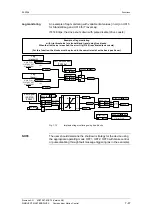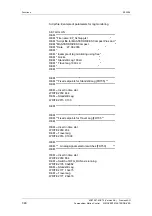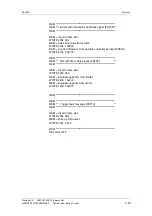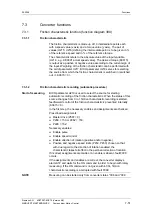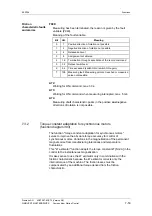
09.2008
Functions
Siemens AG
6SE7087-6QX70 (Version AK)
SIMOVERT MASTERDRIVES
Compendium Motion Control
7-61
7.3.6
Function "speed filter" (function diagram 361)
The free block "speed filter" contains three digital filters of the second
order connected in series. They are always calculated in the time slot of
the speed controller (T0) and can be wired freely. It is usual practice to
insert the filter block in front of the speed controller (P252 = KK0152
and P228 = KK0158) when the PI controller is operated as a speed
controller (P238 = 0 (default)) or downstream of the speed controller
(P252 = K0153 and P260 = KK0158) when the PIR controller is
employed as a speed controller (P238 = 1). The advantage of this is
that vibrations that are injected by means of the speed
set
point (e.g.
position controller output) are also acquired.
To prevent further deadtimes from resulting in the speed control loop in
this configuration, the arithmetic sequence of the individual blocks must
be changed such that the filter block is calculated after the
setpoint/actual value difference has been generated. This can be set in
parameter U963 (arithmetic sequence): U963.42 = 5 (filter), U963.43 =
2 (smoothing elements), U963.45 = 3 (setpoint/actual value difference
generation).
It is possible to improve the stability of the control loop using filters. If
the mechanical transmission elements contain disturbing frequencies
they can be removed with the low-pass filters or band-stop filters.
However, it is important to note that these filters increase the sum of
the small delay times and the substitute delay time of the speed control
loop and can therefore not be used in all cases.
First of all, the natural frequencies of the system must be determined.
The simplest way of doing this is to inject or deactivate a torque
setpoint in steps. The natural vibration of the system overlays the
progression of the speed actual value after the step changes. These
vibrations can be induced by triggering "AUS2" during a speed
controlled acceleration and therefore deactivating the torque suddenly.
If the vibrations are to be induced by injecting a square-wave additional
torque setpoint, the speed controller must be set very slowly so that it
does not intervene to compensate.
A good overview of the vibrations is provided by recording the speed
actual value for a whole series of different speed actual values. The
frequency spectra of the recordings are represented in a staggered 3D
arrangement in a cascade diagram. In such a diagram it is possible to
differentiate between the speed-dependent harmonic components and
the natural frequencies of the system. The speed-dependent harmonic
components which, for example, result from the unbalance or
eccentricity appear as straight lines forming the origin in the cascade
diagram. The natural frequencies of the system appear in the diagram
as lines of constant frequency.
Application and
system analysis

